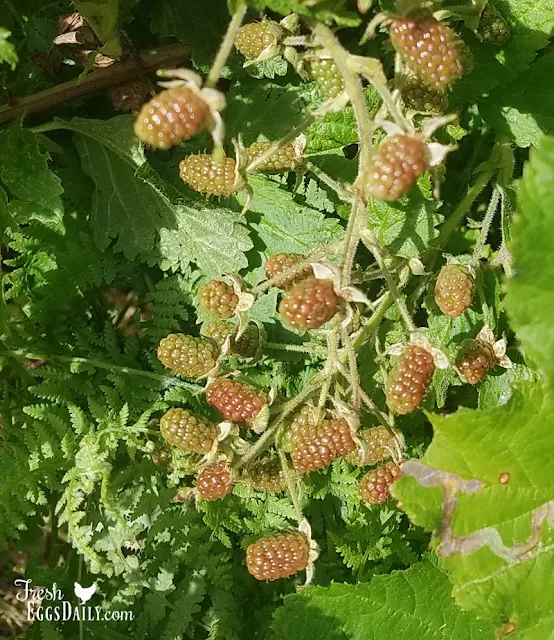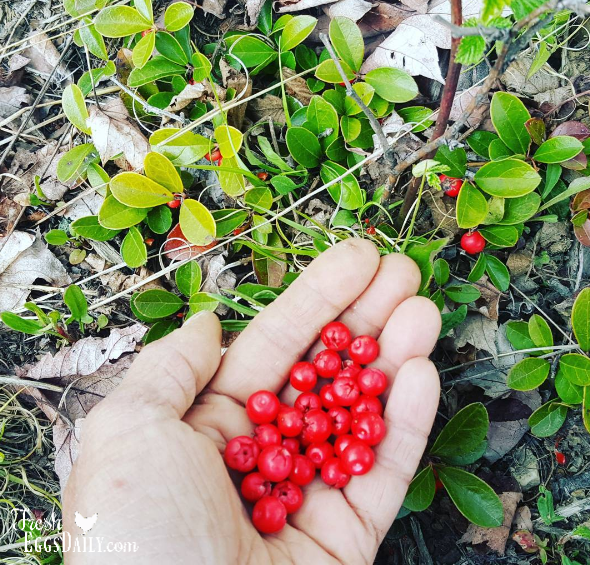Wild Berries on our Farm in Maine
Maine is known for its wild blueberries, so we were thrilled to find a small wild blueberry patch on our farm when we moved here several years ago.
Since berries were something we really were excited about growing here, we also planted some high bush blueberry varieties (completely different than the wild low bush), along with raspberries and black raspberries the first summer we moved here.
We're still waiting patiently for those bushes to mature, so it was exciting to happen upon a huge raspberry patch out behind the chicken coop last summer!
We harvested quarts of berries this season from that patch and have them in the freezer. In fact, there were so many berries, we were happy when the chickens trailed after us one day when we were picking and helped themselves to some too!
But that wasn't the end of the surprises in store for us. We have also discovered some other really interesting berries on our property.
Some I wasn't familiar with before - and had certainly never tasted, so I had some research to do on those. But let's start with the wild blueberries...
Wild Maine Blueberries
Lowbush blueberries grow wild in Maine. Partial to the acidic soil, they need little maintenance or care to thrive. Unlike their cultivated high bush cousins, wild Maine blueberries, as their name implies, grow low to the ground.
They're tiny, barely the size of a pea, and sweeter and more intense in flavor than the larger high bush varieties. And they're the perfect size to just pop into your mouth fresh from the bush, but Wild Maine blueberries are really perfect for pies.
They're also a big favorite with our chickens!
Get My Fresh Maine Blueberry Pie Recipe
The raspberries from our patch were cultivated at some point, I'm pretty sure, but had been left to go wild in recent years. With a little pruning back, I think we'll have a really nice raspberry patch.
Raspberries
As I mentioned, I'm pretty sure that the raspberry bushes out behind the coop were planted intentionally, but then the patch sort of ran wild after that.
The berries are delicious right from the vine, the chickens love them as well, but they also make amazing raspberry jam!
Get My Easy Raspberry Jam Recipe
Tangled in among the raspberry bushes, I also found two blackberry bushes!
We fought the wild birds for the berries, but next year I'll put some netting over the bushes and hopefully we'll have better luck.
Blackberries
Blackberries grow quite well on their own (although they do like to be trellised) and grow in the same conditions as other berries - slightly acidic soil, a good amount of sun etc. - so they're thriving in the raspberry patch!
Blackberries are one of my favorite berries, and this tiered blackberry cheesecake is one of my favorite ways to use them!
Get my Blackberry White Chocolate Tiered Cheesecake Recipe
Growing in the fields and meadows around the house, I found scads of these wild strawberries, also called woodland or Alpine strawberry. They grow wild through much of North America.
Wild "Alpine" Strawberries
They're tiny and sweet and delicious right from the plant, but a friend makes wonderful freezer jam from them. If I get her recipe, I'll add it here for sure!
Our chickens go bananas over these little strawberries.
They often discover them while they're free ranging, or often I'll collect them for the chickens and give them a treat in the run.
These next two berries were some that I had never seen before.
Both red, they are both edible for chickens and humans, unlike some other red berries that can be toxic (honeysuckle, holly, etc.), but both are pretty easy to identify out in the wild.
I was thrilled to find that we have wintergreen and bunch berries growing on our property.
Wintergreen
Wintergreen berries taste minty, just like wintergreen gum. Honest. In fact, they are used to flavor gum, toothpaste, mouthwash and breath mints.
One taste and you'll know you're eating a wintergreen berry. I don't notice that the chickens necessarily like to eat these berries.
I haven't done anything with the berries except to munch on them occasionally when I'm outdoors in the fall (which is when they ripen), but I have read that you can make wintergreen extract and also brew tea from them. Or maybe try making ice cream?!
Wintergreen Ice Cream Recipe
Bunch berries are another red berry that grows in the wild here in Maine.
Also called dwarf dogwood, the berries ripen later in the summer, but we enjoy the small plants with their pretty white flowers until then.
They also seem to be lovers of acidic soil because we find them under stands of pine trees most often as a pretty ground cover.
Bunch Berries
Bunch berries grow on low-lying plants that have pretty white flowers early in the season.
The berries are pretty tasteless, but supposedly a favorite snack of hikers and those who spend lots of time in the woods. I've read that you can also make jelly from them. Also, our chickens love them!
The last berry that we have found on our property, I initially (mistakenly) assumed was elderberry.
The berries are dark purple and about the size of elderberries, but the plant just wasn't looking exactly right to be an elderberry.
Bristly Sarsaparilla
So I did what any BAD Master Gardener does and tasted one of the berries!
It was fairly pleasant tasting, maybe slightly bitter. I knew that even though elderberries can be toxic in large quantities, one wouldn't kill me, so I figured I was pretty safe.
Still not convinced it was an elderberry bush, I did what any GOOD Master Gardener does and emailed some photos to my Master Gardener instructor and asked her what she thought.
After chastising me for eating a berry that I wasn't sure of, she told me that what we had was a bristly sarsaparilla bush!
Well, now.
That was exciting. Like elderberries, bristly sarsaparilla berries really shouldn't be eaten raw, but again, one wasn't going to kill me.
Historically, sarsaparilla root and tea made from the root has been used to treat a plethora of health issues including arthritis and liver and heart disease.
I haven't given any of these berries to the chickens and they haven't eaten any on their own that I've noticed, but the wild birds sure do seem to enjoy them!
So, that's a quick rundown of the various wild berries we've been lucky enough to find on our property here in Maine.
The moral of the story is, take a look around to see what you have on your property or growing in the woods, don't eat any berry or plant unless you're absolutely sure of what it is, and if you're unsure, your local Master Gardener or State University Extension Office is a good starting point.
Although there are many types of edible berries, there are also a few that are toxic. Some are only safe to eat after being cooked, like the elderberry and sarsaparilla berry.
I have included photos of both the berries and leaves in this article to help you try to identify berries you might have on your property, but it's always good advice not to eat any berries you find until you have a reputable source verify exactly what you've got!
The book Good Berry Bad Berry by Helen Yoest (St. Lynns Press, 2016) is another good starting point for learning how to identify berries you find in the wild. I keep this book handy to refer to after my many walks in the woods.
A rule of thumb to follow when it comes to berries is:
White, yellow or green berries - stay away! About 90% of these are poisonous.
Red berries - use caution! You have about a 50/50 chance that they're edible, and a better chance they're edible if the berries grow singly - those in clusters are more likely to be poisonous.
Blue and black berries - you're generally safe eating these, although there are exceptions.
https://www.outdoorlife.com/photos/gallery/2014/09/11-toxic-wild-plants-look-food
https://extension.umaine.edu/blueberries/
https://www.almanac.com/plant/raspberries
https://extension.umaine.edu/publications/2066e/
https://statesymbolsusa.org/symbol-official-item/maine/state-plant-state-food-agriculture-symbol/wintergreen
https://gobotany.newenglandwild.org/species/aralia/hispida/







































